Perfect Roasted Turkey Recipe: Your Ultimate Guide to a Juicy & Crispy Holiday Bird
Roasted Turkey Recipe – Get the perfect oven roasted turkey for your holiday table with this simple and delicious recipe. The meat stays juicy and tender every time!
This post is sponsored by the National Turkey Federation. All thoughts and opinions are 100% my own.
As the aroma of pumpkin spice fills the air and festive lights begin to twinkle, we know the holidays are officially just around the corner. For many, the centerpiece of these cherished celebrations is undoubtedly a magnificent roasted turkey. But let’s be honest, the thought of preparing this grand bird can sometimes feel daunting. The fear of a dry, flavorless turkey is a common holiday anxiety!
However, I’m here to assure you that achieving a crisp, golden-brown skin, incredibly tender, and bursting-with-flavor turkey is not only possible but also surprisingly simple. Growing up, our holiday tables for both Thanksgiving and Christmas always featured a delicious turkey, and that tradition taught me the secrets to making it truly memorable. Today, I’m excited to share all my essential tips and tricks to ensure your holiday turkey is nothing short of perfect, leaving your guests amazed and satisfied.
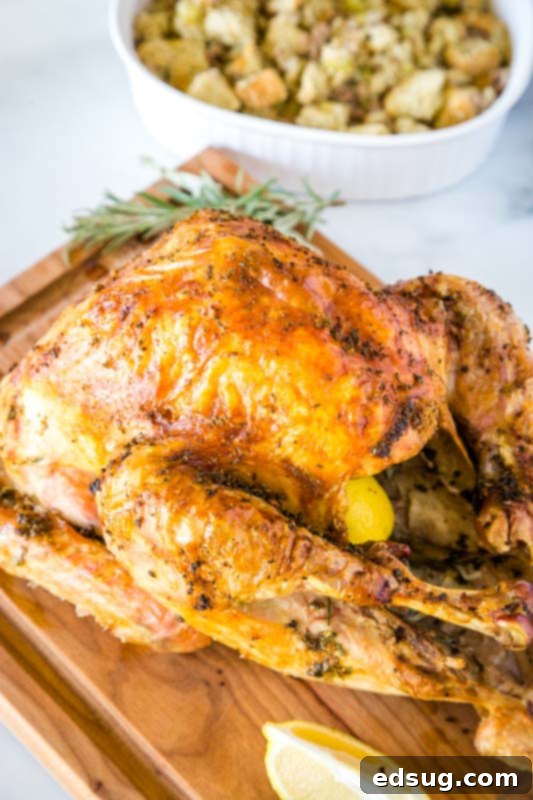
Mastering Your Holiday Turkey: Essential Tips
Preparing a delicious holiday turkey involves a few key steps that, when followed carefully, guarantee a succulent and flavorful result. Here are my top five tips for roasting the perfect whole bird:
- Choosing Your Turkey Size: When selecting your fresh or frozen turkey, a general rule of thumb is to allow 1 pound of turkey per person. For guests with heartier appetites, or if you’re dreaming of ample leftovers (and who isn’t?), plan for 1 ½ to 2 pounds per person. This ensures everyone gets enough and you have some for delicious post-holiday meals.
- Proper Thawing is Crucial: If you’ve opted for a frozen bird, patience is key. Allow approximately 24 hours of thawing time in the refrigerator for every 4-5 pounds of turkey weight. This slow, safe thawing method prevents bacterial growth and ensures even cooking.
- Calculate Roasting Time: For a fully defrosted turkey, plan for about 20 minutes per pound in a 350°F (175°C) oven. If you’re using a fresh turkey, the cooking time will be slightly less, around 10-15 minutes per pound. Always use a meat thermometer to confirm doneness, as oven temperatures can vary.
- The Importance of Resting: This step is often overlooked but is absolutely vital for a juicy turkey. After removing the turkey from the oven, allow it to rest, tented loosely with foil, for at least 20 minutes before carving. This allows the juices to redistribute throughout the meat, resulting in a more tender and flavorful bird.
- Flavoring with Herb Butter: My secret weapon for that irresistible crispy skin and deeply flavored meat is a generous herb butter rub. Applied directly under and over the skin, this mixture not only creates a golden crust but also infuses the turkey with incredible aromatic notes and keeps it moist.
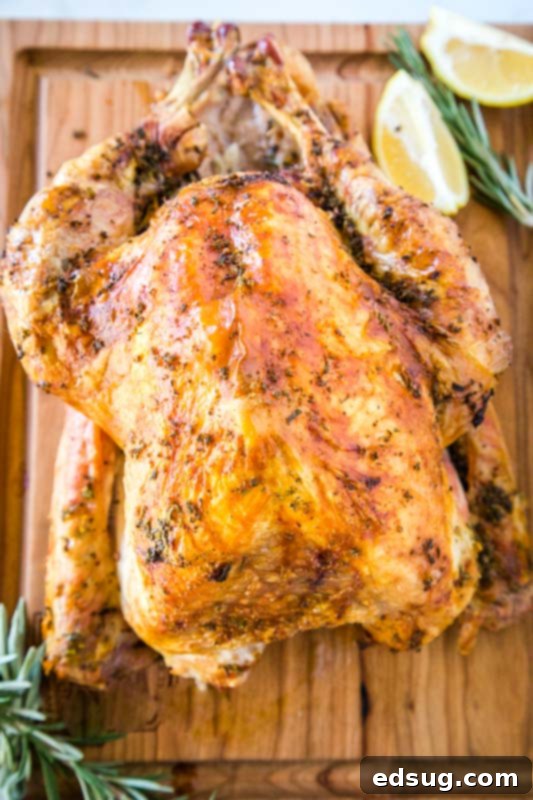
How to Safely Thaw Your Turkey
When you’re at the grocery store, you typically have the choice between a fresh or frozen turkey. Frozen turkeys are far more common and often more economical, but they require careful planning for thawing. Improper thawing can lead to food safety issues and a less-than-ideal final product. Here’s how to do it right:
Refrigerator Thawing Method (Recommended)
This is the safest and most recommended method, though it requires ample time. You will want to thaw the turkey in its original wrapper on a tray or in a pan to catch any drips, placed on the lowest shelf of your refrigerator. Plan approximately 24 hours of thawing time for every 4-5 pounds of turkey. For example:
- A 4-pound turkey: 1 day
- A 12-pound turkey: 3 days
- A 16-pound turkey (like mine was): 4 full days
- A 20-pound turkey: 5 days
As you can see, you need to buy your frozen turkey well in advance to ensure it thaws completely before your cooking day. A partially frozen turkey will cook unevenly and take much longer.
Cold Water Thawing Method (Faster Alternative)
If you’re short on time, the cold water method can speed things up, but it requires more attention. Keep the turkey in its original airtight packaging. Submerge the wrapped turkey in cold tap water, changing the water every 30 minutes to keep it cold and prevent bacteria from growing. Allow about 30 minutes per pound of turkey. For example, a 16-pound turkey would take approximately 8 hours to thaw using this method. Cook immediately after thawing.
What Not to Do
Never thaw a turkey at room temperature on the counter. This allows the outer layers to warm up and enter the “danger zone” (40°F-140°F / 4°C-60°C) where harmful bacteria can multiply rapidly, even if the center is still frozen.
How to Prep Your Turkey for Roasting
Proper preparation is crucial for a perfectly cooked and flavorful turkey. Once your turkey is fully thawed, follow these steps to get it ready for the oven:
- Remove Neck and Giblets: As soon as you remove the turkey from its plastic wrap, reach into both the neck and body cavities to remove the neck and the giblet bag (which usually contains the liver, gizzard, and heart). These can be used to make a flavorful gravy or stock, or simply discarded if preferred.
- Pat Dry Thoroughly: Use paper towels to pat the entire turkey, inside and out, as dry as possible. This step is incredibly important for achieving that coveted crispy skin. Moisture on the skin will steam rather than crisp.
- Season the Cavity: In a small bowl, mix together the initial salt, black pepper, and garlic powder. Generously sprinkle this seasoning blend into the turkey’s cavity.
- Add Aromatics: Stuff the cavity with quartered onion, lemon, bay leaves, sage, rosemary, thyme, and crushed garlic. These aromatics will release their fragrant oils and steam during cooking, infusing the meat with incredible flavor and moisture from the inside out.
- Tuck Wings and Tie Legs: Fold the ends of the turkey wings under the bird. This prevents them from burning and helps maintain the turkey’s shape. Then, bring the turkey legs together and tie them securely with kitchen twine. Trussing helps the turkey cook more evenly and makes for a more appealing presentation.
- Apply Herb Butter Rub: This is where the magic happens! In a food processor or by hand, blend room temperature butter with minced garlic, fresh sage, thyme, and rosemary until well combined. Gently loosen the skin over the breast and thighs (be careful not to tear it) and generously rub about half of the herb butter directly onto the meat under the skin. Then, rub the remaining herb butter all over the exterior of the turkey. Season the outside generously with additional salt and pepper.

How Long to Cook Your Turkey for Perfect Doneness
Determining the precise cooking time for a turkey can be one of the most stressful parts of holiday meal prep. While a general rule of 15-20 minutes per pound is a good guideline, the only truly accurate way to know if your turkey is done is by using a reliable meat thermometer. This simple tool is your best friend in preventing both undercooked (unsafe) and overcooked (dry) turkey.
Cooking Temperature and Timing
For this recipe, we start the turkey in a high-heat oven to achieve that beautifully crispy, golden skin, then reduce the temperature for even cooking throughout:
- Preheat your oven to 450°F (230°C). Place the prepared turkey in a sturdy roasting pan with about 1 cup of water in the bottom. This water helps create steam, preventing the pan drippings from burning and contributing to a moister environment.
- Initial High-Heat Roast: Bake the turkey at 450°F (230°C) for 30 minutes. During this time, the high heat will rapidly crisp and brown the skin.
- Lower Temperature for Even Cooking: After 30 minutes, reduce the oven temperature to 350°F (175°C) and continue to cook for an additional 2 to 2.5 hours, or until the internal temperature reaches the target. The total cooking time will vary based on the exact size of your turkey, but typically expect about 15 minutes per pound for a defrosted bird.
Checking for Doneness with a Meat Thermometer
Insert the meat thermometer into the thickest part of the thigh, making sure not to touch the bone. The turkey is safely done when the temperature in the thigh reaches 165°F (74°C). You can also check the thickest part of the breast, aiming for 160-165°F (71-74°C). Remember that the temperature will rise slightly during the resting period.
The Indispensable Resting Period
Once the turkey reaches the target internal temperature, remove it from the oven. Loosely tent the turkey with aluminum foil and let it rest for a minimum of 20-30 minutes before slicing. This crucial step allows the muscle fibers to relax and the juices to redistribute evenly throughout the meat. If you carve it too soon, those delicious juices will run out onto your cutting board, leaving you with a drier bird. Resting is key to achieving that tender, juicy perfection!
Essential Food Safety Reminders!
When preparing turkey, especially for a large gathering, food safety is paramount. Follow these simple tips to ensure everyone enjoys a delicious and safe holiday meal:
- Don’t Rinse Your Turkey: It’s a common practice, but rinsing raw turkey can spread bacteria (like Salmonella) around your kitchen sink and countertops through splashing water droplets. Instead, simply pat the turkey dry with paper towels.
- Stuffing Safety: We highly recommend cooking your dressing (stuffing) separately from your turkey. If you do choose to prepare a stuffed turkey, it’s critical to ensure the stuffing itself reaches an internal temperature of 165°F (74°C) to kill any bacteria that may have come into contact with the raw turkey juices. Use a food thermometer to check both the turkey and the stuffing.
- Thorough Handwashing and Sanitation: Always wash your hands thoroughly with soap and warm water for at least 20 seconds after handling raw turkey. Don’t forget to disinfect any surfaces, cutting boards, utensils, or spice containers you may have touched along the way. Use a food-safe disinfectant spray or a bleach solution.
- Prevent Cross-Contamination: Use separate cutting boards for raw poultry and other foods like vegetables, bread, or cooked items. Also, use clean plates and utensils for serving the cooked turkey – never use the same ones that touched the raw bird.
- Refrigerate Perishable Foods Promptly: The “danger zone” for bacterial growth is between 40°F and 140°F (4°C and 60°C). Refrigerate all perishable foods, including turkey leftovers, within two hours of cooking. If food has been left out longer than two hours, it should be discarded.
- Enjoy Leftovers Safely: Food stored in the refrigerator should stay below 40°F (4°C). Enjoy your delicious Thanksgiving leftovers within 3-4 days. Alternatively, you can freeze your turkey for use over the next several weeks or even months, ensuring you get the most out of your holiday bird.
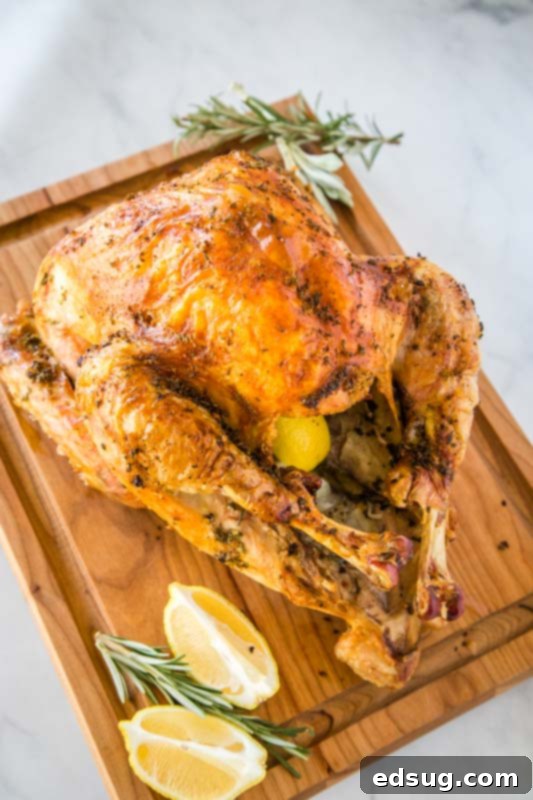
It’s estimated that approximately 45 million turkeys are consumed during Thanksgiving alone, with about 95% of Americans including turkey in their holiday feast. Given its prominence on the holiday table, why settle for anything less than delicious? Forget the dried-out, bland turkey you might remember from childhood! This recipe is designed to deliver a show-stopping bird that is consistently juicy, flavorful, and boasts an incredibly crispy skin.
The true key to this perfect roasted turkey lies in the combination of a rich herb butter rub and a strategic cooking method. The generous amount of butter, slathered under and over the skin, is responsible for that glorious, deeply golden, and irresistibly crispy skin everyone craves. This buttery skin also acts as a protective layer, helping to lock in the turkey’s natural juices as it cooks, which in turn leads to incredibly tender and moist meat every single time. To achieve this crispy exterior while ensuring the meat cooks perfectly through, we start the turkey in a super hot oven for an initial blast, then reduce the heat to allow for a gentler, more even roast.
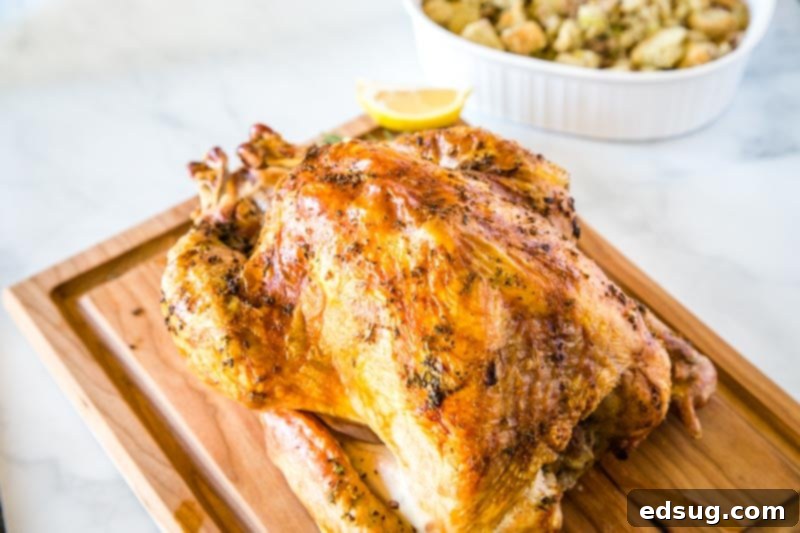
Beyond the butter, the fresh herbs and aromatics play a pivotal role in infusing the meat with profound flavor. By placing garlic, rosemary, sage, thyme, lemon, and onion directly into the turkey’s cavity, they release their delightful aromas and flavors throughout the cooking process. This internal flavoring method ensures that every bite of turkey is imbued with herbaceous goodness, complementing the rich poultry notes beautifully.
This roasted turkey recipe is genuinely easy to follow, making it accessible even for novice cooks, and the results will undoubtedly impress all of your holiday guests. That perfectly golden, crispy crust and the promise of a truly juicy turkey will have everyone in awe, wondering how you achieved such culinary mastery. Be warned: once your family and friends taste this magnificent bird, you might just find yourself nominated to host Thanksgiving every year going forward!
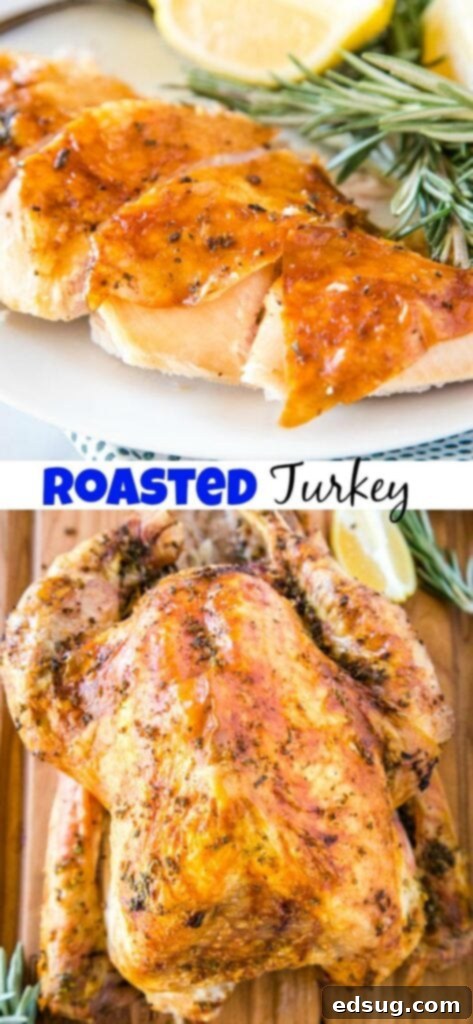

Roasted Turkey Recipe
Pin Recipe
Rate Recipe
Print Recipe
Ingredients
- 12-15 pound turkey
- 1 large onion, quartered
- 1 lemon, quartered
- 3 bay leaves
- 2 tsp salt
- 1 tsp garlic powder
- 1/2 tsp black pepper
- 2 sprigs rosemary
- 2 sprigs sage
- 2 sprigs thyme
- 2 cloves garlic, crushed
Herb Butter Rub
- 8 Tbsp butter, room temperature
- 2 cloves garlic, minced
- 2 Tbsp fresh sage, minced
- 2 Tbsp fresh thyme, minced
- 1 Tbsp fresh rosemary, minced
- Salt and Pepper
Instructions
-
Remove turkey from the fridge and let stand at room temperature for at least 30 minutes before baking to allow it to come slightly closer to room temperature, promoting more even cooking.
-
Remove the neck and giblets from both cavities of the turkey and pat the entire bird dry with paper towels.
-
Preheat oven to 450 degrees F (230°C).
-
In a small bowl, mix together 2 tsp salt, 1 tsp garlic powder, and ½ tsp black pepper. Sprinkle this mixture generously into the inside cavity of the turkey to season.
-
Place the quartered onion, lemon, bay leaves, 2 sprigs of sage, 2 sprigs of rosemary, 2 sprigs of thyme, and 2 crushed garlic cloves into the turkey cavity.
-
Bring the legs together and tie them securely with kitchen string or twine.
-
Tuck the tips of the wings under the turkey to prevent them from burning.
-
In a small food processor (or bowl, using a fork), mix together 8 Tbsp room temperature butter, 2 cloves minced garlic, 2 Tbsp fresh minced sage, 2 Tbsp fresh minced thyme, and 1 Tbsp fresh minced rosemary until well blended.
-
Generously season the entire outside of the turkey with additional salt and pepper.
-
Use your fingers to gently loosen the skin over the breast and thighs, then rub about half of the butter mixture evenly under the skin. Apply the remaining butter mixture over the entire exterior of the turkey until it is well coated.
-
Place the turkey in a sturdy roasting pan with about 1 cup of water added to the bottom of the pan.
-
Bake for 30 minutes at 450°F (230°C) until the skin is beautifully golden. Then, reduce the oven temperature to 350°F (175°C) and continue to cook for an additional 2 1/2 hours, or until a meat thermometer inserted into the thickest part of the thigh (without touching bone) reads 165°F (74°C). Total cooking time will vary based on the size of your turkey, but generally count on about 15 minutes per pound.
-
Remove the turkey from the oven and immediately tent it loosely with foil. Let it rest for 20-30 minutes before slicing to allow the juices to redistribute, ensuring a tender and moist bird. Serve warm and enjoy your perfect roasted turkey!
Nutrition
Nutrition information is automatically calculated, so should only be used as an approximation.
Additional Info
Like this recipe? Leave a comment below!
